It’ll be great if the website or blog you invested a lot of effort into pays you back with revenue. You might have considerable traffic, but you’ll find it challenging to make money without ads on your site.
According to Statista, global spending on banner advertising hit $162 billion in 2023 and is projected to reach $207 billion by 2027. This article answers the question of “how to get ads on my website” and earn your share of this huge global ad spending.
Is it worth it to put ads on your website?
Yes, placing ads on your site and making money is worth it. DoubleVerify’s study shows that 69% of consumers will likely engage with contextual ads, so you can earn from ads related to your blog or website content.
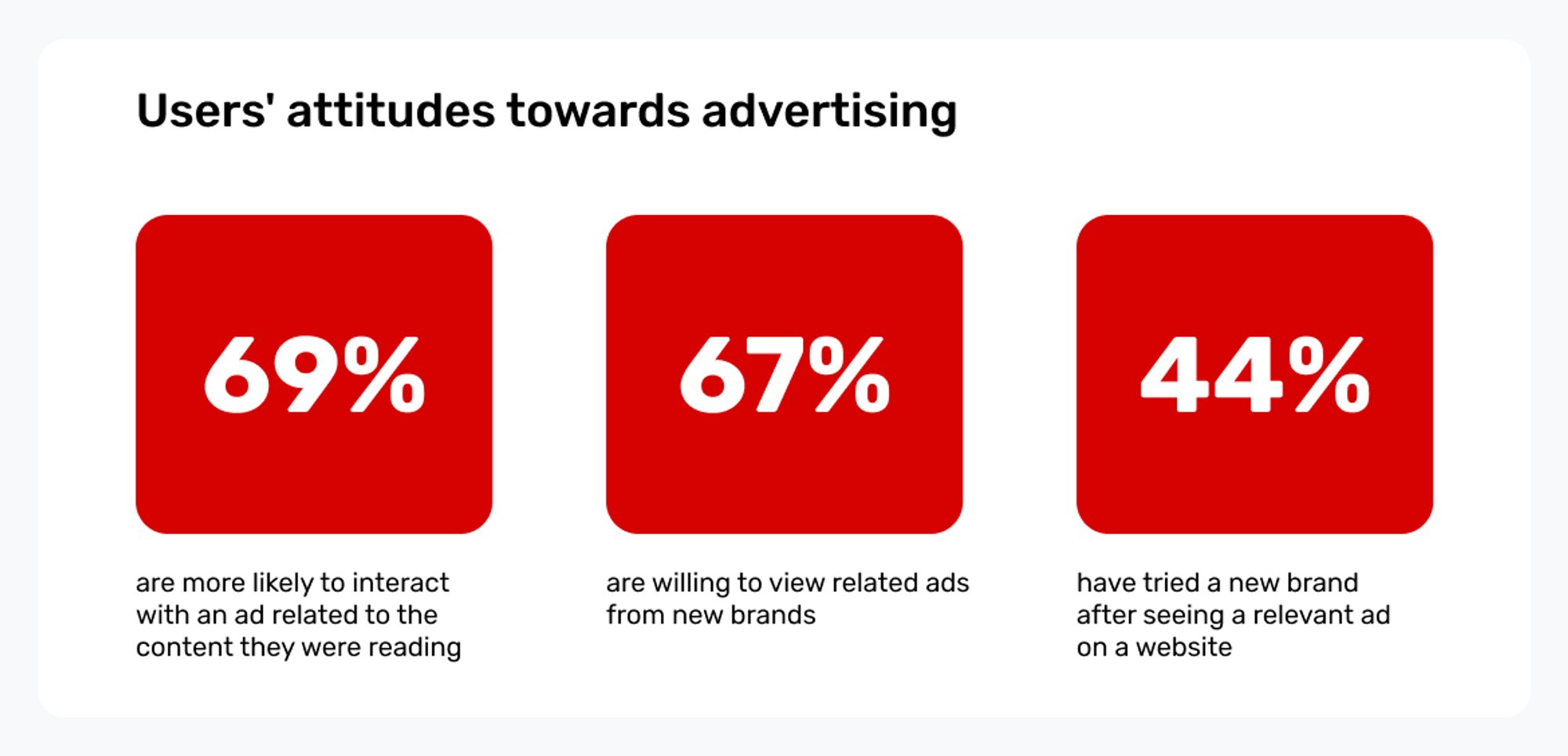
Adsterra lets you easily add ads to your website and earn revenue. Our platform gives you access to 15,000+ advertisers across different niches and with creative ad formats, including Social Bar, Popunders, Native Banners, and Display ads.
Other good reasons for putting ads on your site include:
- Building long-term relationships with advertisers and customers.
- Earning money to invest in upgrading your site and adding more features.
- Earning revenue to build a workspace and hire others to help grow the site.
- Broadening your content niche.
- Increasing brand awareness & trust.
How much do advertisers pay to be on your website?
Advertisers pay no specific amount to place an ad on your site. It depends on your traffic, audience, and niche, among other factors.
You can check out this case study of a blogger who earned up to $1,350 weekly via the Adsterra network. This blogger generated traffic for his site via Snapchat.
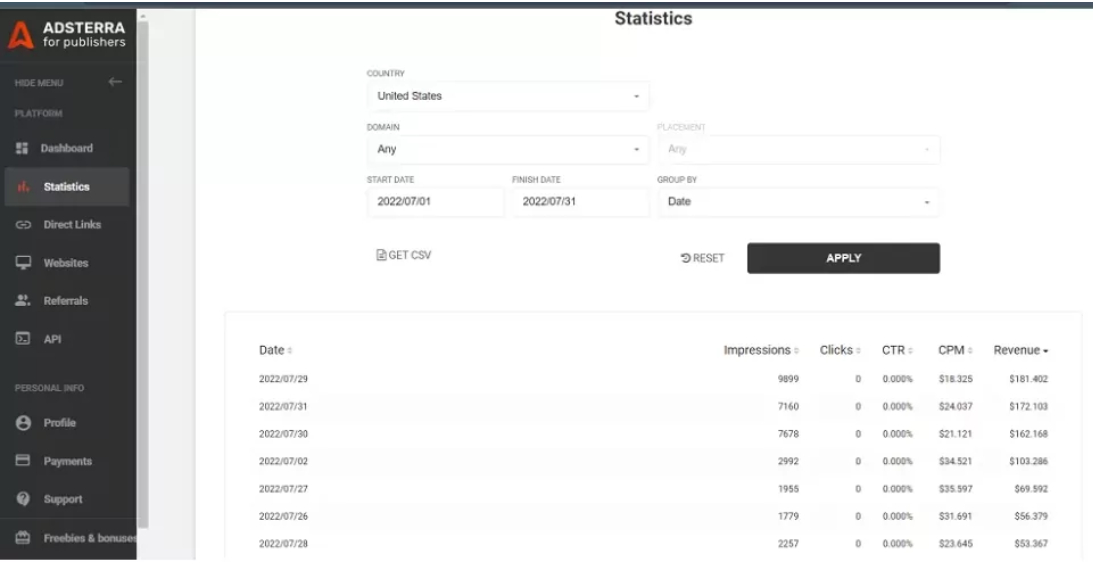
Another blogger earned up to $800 daily by drawing traffic to his website from Twitter.
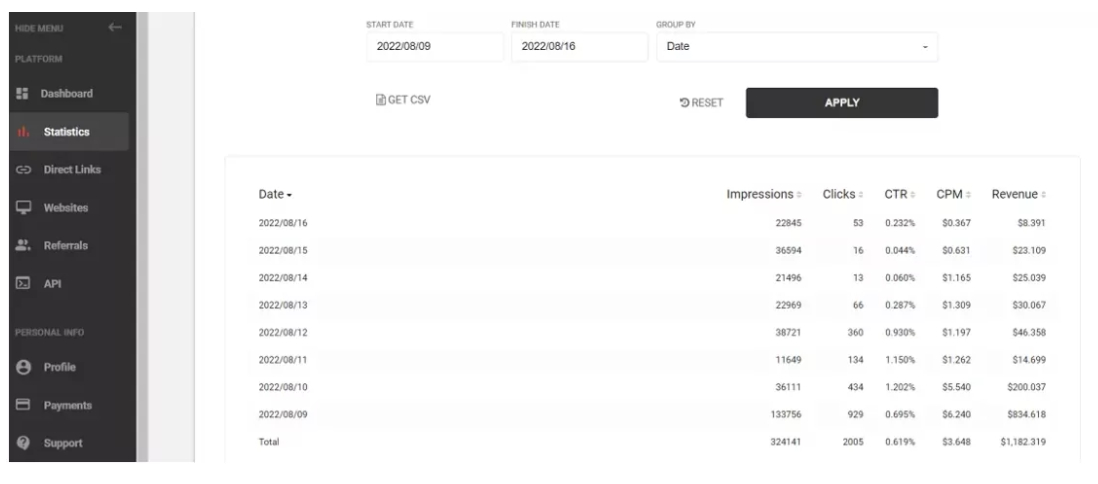
Ad formats for monetizing your website
There are many formats for putting ads on your website, e.g., Native ads, Banners, Direct Link, etc. Before we’ll dive deeper into these formats for advertising on your website below, check the article about Selling Advertising on Your Website.
Display ads
If you ask about advertising on your website, Display advertisement is the most common answer you’ll get. Display ads utilize text, images, animations, and videos to promote products or services. You usually place them in a static position on a page, wherein everyone who scrolls through that page’s content also sees the ad.
Display ads are simple to implement. The advertiser or advertising network provides the graphic, and you place it on any desired position on your website. For example, you can place it at the top of your website, and everyone who opens it sees the ad.
Display ads are eye-catching and targeted at a specific audience, which makes them deliver good results. It’s an effective way to monetize the content you work hard to create for your audience. For more information, you can see our article on how to make money with Display ads.
Interstitial ads
Interstitials are another effective type of ads for your website. Unlike Display ads that occupy a small part of the screen, Interstitials cover the viewer’s entire browser web page or device screen. Interstitial ads are highly effective because of their size and screen occupation.
Interstitial ads are usually shown after specific user actions, e.g., when a viewer clicks on another article, or a gamer pauses their game. You can also show it immediately after someone lands on your website. However, it’s a bad idea to suddenly cover the user’s screen with an ad while they scroll through content.
The primary advantage of Interstitial ads is that they offer better performance and results than other formats. For more information, you can see our guide on how to earn from Interstitials.
Popunders
Popunders are worth considering if you want to add ads to your website and get paid. Popunder ads appear behind an active browser window. The ad stays behind the window until the user’s action triggers it, e.g., clicking a link.
Popunders are the opposite of Popup ads, which appear on the browsing window as the user scrolls through content. Popups are intrusive and easily stopped by ad-blocking tools. Popunders are less intrusive and can’t be easily blocked.
To implement Popunders, you first insert the ad code into your website’s HTML structure. The code gets triggered when a user clicks or hovers over a specific element on the web page (you specify this element in the HTML code). After it’s triggered, the user views the Popunder ad before proceeding to their next action.
Popunder ads are very effective for advertisers and help them earn sizeable amounts of money.
Native advertising
Native ads always come up when it comes to advertising on your website. Their uniqueness helps generate clicks for advertisers and revenue for publishers.
Native ads match the style and content of the website they’re placed on, such that the user may not even notice that it’s an ad. For instance, if you run a technology blog, you can create a sponsored article reviewing a specific product. This sponsored ad appears like any other blog post your readers are used to. You can add a “Sponsored Post” or “Ad” at the beginning to declare it as a paid promotion, but it nonetheless matches your website’s look and feel.
Native advertising offers great performance because it matches what your audience is already looking for. Viewers are more likely to click on an ad they can relate to, delivering engagement for the advertiser and revenue for the publisher.
In-Text advertising
Advertising on your website is not complete without In-Text advertising. This format involves monetizing specific keywords within your content with outbound links. It is also called Inline advertising.
For example, you run a fashion blog and write a long review about dressing up for the summer. You can monetize specific keywords within your review, like “warm clothing,” “T-shirts,” and “Jeans.” You’ll place links in these keywords that lead to your advertisers’ websites, e.g., “Jeans” leading to an online store that sells jeans clothing.
In-Text ads are subtle and effective. With this format, you’re both directing your audience to a valuable online resource and making money, a win-win for both sides.
Adsterra’s Direct Link is a good example of advanced In-Text advertising as using these mechanics allows working with multiple offers. You can check out the below case study of an entertainment blogger earning $2,000 from Direct Links on this site.
What is Google AdSense, and how does it work?
Google AdSense is the most popular advertising network, enabling website owners to monetize their content with Display ads. AdSense is popular because it’s free to use and offers a vast advertising inventory to publishers. This network doesn’t have strict traffic requirements; both small and large publishers can use it to earn money from their content.
AdSense does the heavy lifting for publishers, who only need to add the code to their website and show visitors ads. However, it’s not always the best choice. Some website categories are best served by niche networks tailored to their audience.
Why consider Adsterra for your monetization strategy?
Adsterra is one of the best Google AdSense alternatives you can choose. Our platform offers a variety of ad formats (Popunders, Banners, Interstitials, etc.) to help you maximize your ad revenue. We offer 24/7 customer support, with our support team ever willing to answer your inquiries.
Our ad network currently serves over 30 billion monthly ad impressions. You can work with advertisers from around the globe and find the perfect ads for your audience.
How to get ads on my website?
Before putting ads on your site, there are some important things to pay attention to, including:
- Traffic: You should have a significant audience visiting your site to stay attractive to advertisers. The more visitors and page views, the more willing advertisers want to work with you. Advertising platforms, including Adsterra, don’t have minimum traffic requirements. They’re more concerned about the quality of your traffic and user retention.
- Quality content: You should focus on publishing quality content that people will want to see. This goes a long way in attracting traffic to your website. By the way, we have a detailed guide that will teach you how to create high-quality content for your website and blog:
- Design and functionality: Your website should be easy to navigate and look pleasing to the eye. Also, optimize it to load as fast as possible on any web browser.
If you have already taken care of the quality of content, ease of navigation and download speed, then it’s time to make money on advertising. The major ways to put ads on your site include:
1. Promote a product via affiliate marketing
Affiliate links allow you to make money by promoting someone else’s product on your site. You’ll earn a commission each time someone referred from your website buys the product.
There are several ways to market affiliate products. You can post a banner ad on your site that links to the affiliate site. Alternatively, you can write a blog post about the product and include the affiliate link.
Different affiliate programs have different commission structures and minimum payouts. Watch out for these metrics and read the fine print before choosing an affiliate program.
2. Use ad networks
Ad networks are brokers between advertisers and publishers. By signing up on one, you don’t need to struggle to find advertisers to place ads on your site. Adsterra is one of the best ad networks for many publishing niches, including iGaming, VPN, Utilities, etc.
Adsterra has over 15,000 advertisers that publishers can connect with after signing up. It supports different ad formats for desktop and mobile displays; you will get any of them in minutes. With our vast network of advertisers, you can easily find the ideal ads for your website’s audience.
You can get your website approved in as low as 10 minutes and gain access to a vast pool of advertisers. Enjoy high CPMs, friendly customer support, and a referral program that can earn you a healthy extra income.
3. Approach advertisers directly
If your site gets considerable traffic, you can find potential advertisers in the same niche and pitch to them directly to place ads on your website. This method is more strenuous than using an ad network, but you often make more money.
If you want to contact potential advertisers, it’s important to do it professionally. Write a formal email pitching your website and what the advertiser will gain from working with you. Be ready to provide factual information about your site and audience. The more information you offer, the more willing they’ll want to work with you.
4. Create a media kit
A media kit is a pre-packaged promotional material for your website that potential advertisers will read. This kit will contain in-depth information about your site and its traffic, e.g., the number of daily visitors, monthly visitors, bounce rate, number of newsletter subscribers, etc.
The idea of a media kit is to have metrics ready for every advertiser considering working with you. They can download the kit instead of contacting you to provide these metrics every time.
A media kit makes it easy for advertisers to find information about your site and know if you’re a suitable partner.
5. Sign up for blogging ad programs
If you run a blog, you can sign up for an ad program built specifically for blogs. These programs function just like ad networks. They have a network of advertisers seeking publishers to work with. If your blog is accepted into the program, then an advertiser can easily find you and offer a partnership.
Note that your traffic is a major consideration for these types of programs. Finding advertisers willing to work with you will be difficult without large volumes of traffic.
6. Insert an “advertise” link on your website
If you observe many popular websites, you’ll find an “advertise” link on the footer that takes you to a page where interested advertisers can contact the owner. This link makes it easy for any potential advertiser to contact you for a pitch. Otherwise, they may struggle to get your contact information and give up after many unsuccessful attempts.
The best place to put an “advertise” link is on your website’s footer or top menu bar. These are where people can easily find them.
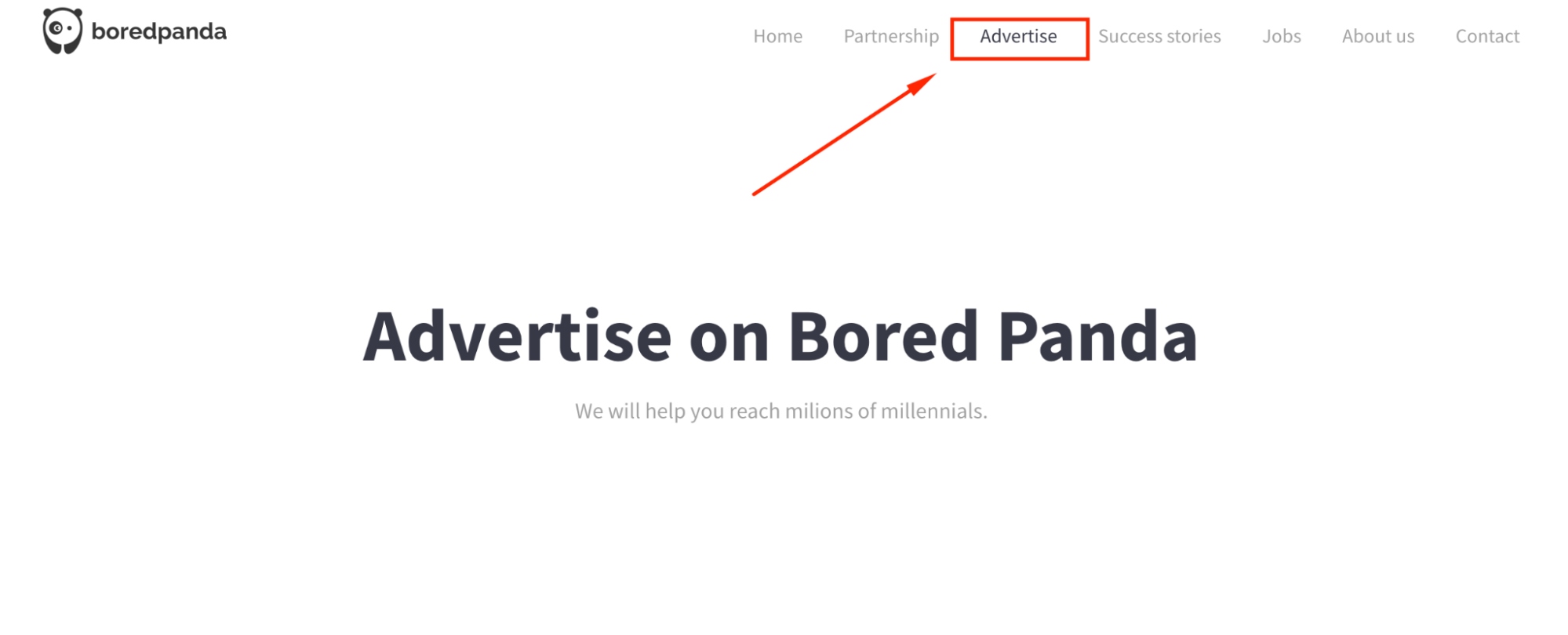
Recommendations for publishers
There are other essential tips for how to place ads on your site successfully. They include:
Your website should be mobile-friendly
According to Statista, half of the global website traffic comes from mobile phones, so optimizing your site to be mobile-friendly is essential. More so, mobile-friendly websites rank higher on search engines. Your site should meet Google’s mobile standards, at least.
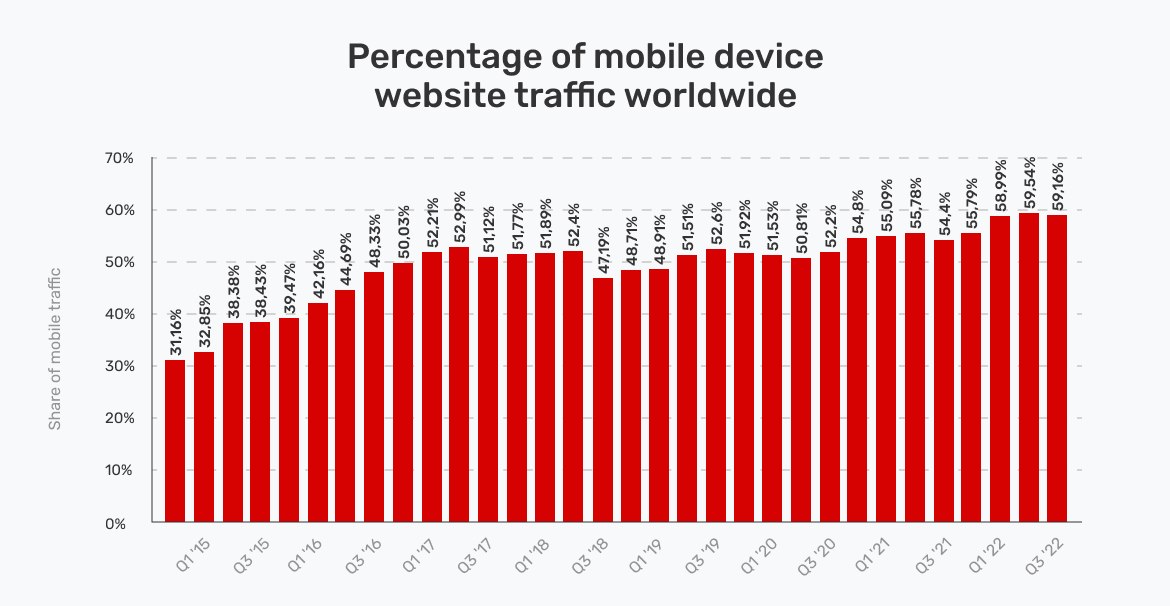
Adsterra offers mobile-friendly ad formats. Its Social Bar shows unprecedented CTRs performing on any platform, including iOS. These formats look good on mobile phones and match the look and feel of your site.
Search engine optimization
Search engines are the most common way to generate organic traffic for your website. Search engine optimization involves writing your content in a way that makes it rank high on search engines. You can use specific keywords and add images and infographics to increase the chances of ranking higher.
Putting ads on your website — FAQs
There’s no specific number of ads to place on your site. It depends on your site design and the volume of content. A healthy ratio is for 30% of a webpage to be dedicated to ads and 70% to the main content.
You can increase the number of ad units if you combine them with different user experiences and mechanics. For example, a popunder ad would not open unless the user closes the browser window, so you can add it to the typical number of banner ads. Combining different formats allows you to increase the number of ads without ruining the user experience.
You can place many types of ads, including Display, Banners, Native, etc. You can use multiple formats simultaneously, placing each in strategic positions to maximize your revenue.
Conclusion
‘How to get ads on my website’ is a question that many publishers ponder. We wrote this article to answer your question and show you the best ways to place ads on your site and make money.
If you’re searching for an ad network, consider using Adsterra because it gives you access to thousands of high-paying and credible advertisers across different niches.
